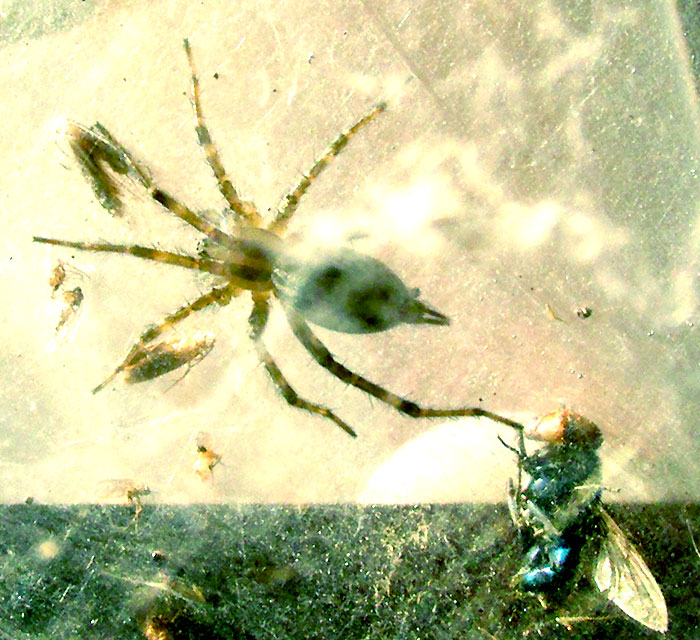Excerpts from Jim Conrad's
Naturalist Newsletter
entry dated January 1, 2022, issued from near Tequisquiapan, elevation about 1,900m (6200 ft), ~N20.57°, ~ W99.89°, Querétaro state, MÉXICO
WESTERN FUNNELWEB SPIDER

In the corner of a basement window in a house at the edge of a small village adjacent to weeds, a grassy area and a line of mostly mesquite trees, the above web had been noticed for a couple of months. It's a funnel web, with the spider's shadowy form vaguely visible above at the funnel's low, narrow point, feeding on a recent capture. At this elevation and in January it's a chilly basement, and when sunlight enters the window, the spider passes into it to bask:

This spider is different from most species in that two small, fingerlike spinnerets project from large, teardrop-shaped abdomen's rear end. Spinnerets are silk-spinning organs. Most spiders have six of them, but some have eight, four or two. Also, usually spinnerets occur on the abdomen's underside, are smaller, and don't project backward like these.
In a funnel web when you see a spider with such big spinnerets, a very good guess is that you have a member of the Funnel Weaver Family, the Agelenidae. Moreover, the abdomen being so large compared to the front section, the cephalothorax, and having such long legs relative to body size, and with dark stripes running lengthwise on both body segments, the best bet is that you have the genus Agelenopsis, generally known as Grass Spiders, since typically Agelenopsis species spin their webs on the ground amid grass and other low herbage and stones.

The excellent Ph.D. dissertation by Julieta Maya Morales, dated 2015 and entitled "Sistemática de las Arañas de la Familia Agelenidae (Araneae: Araneomorphae) de México," finds three species of Agelenopsis occurring in Mexico, of which only one is present in our area, and that's AGELENOPSIS APERTA. Internet pictures match our spider better than any other illustrated member of the Funnel Weaver Family.
BugGuide.Net describes the distribution of Agelenopsis aperta as Kansas south to Texas and west to California in the US. In Mexico, the dissertation gives the species' Mexican occurrence as northern Mexico as far south as Mexico City and Hidalgo state, which covers our area. While the spider's habitat is described as varied, from grasslands to lava beds to rangeland, Richard Bradley in his 2012 book Common Spiders of North America tells us that occasionally it turns up in people's homes or other buildings, where its webs are spun in corners and similarly undisturbed locations.
BugGuide.Net gives our spider the English name of Western Funnel Spider, which makes sense in the US but not in Mexico. The GBIF.Org portal, at the international level, calls it the Desert Grass Spider.
In funnel webs the spider waits at the bottom of the funnel until motion on the flat part of the sheet is sensed, when it rushes out and captures the prey. If a threat is sensed, the spider can escape through the hole at the funnel's bottom. However, silk in these webs isn't sticky. Small arthropods simply fly into the area above the funnel, hit strands seemingly randomly placed, tumble onto the sheet, and by that time the spider has them. Though their bites aren't medically significant to humans, Agelenopsis aperta venom takes less than a second to paralyze an insect.
There's plenty of documented information regarding the behavior of this spider on Wikipedia's Agelenopsis aperta page.